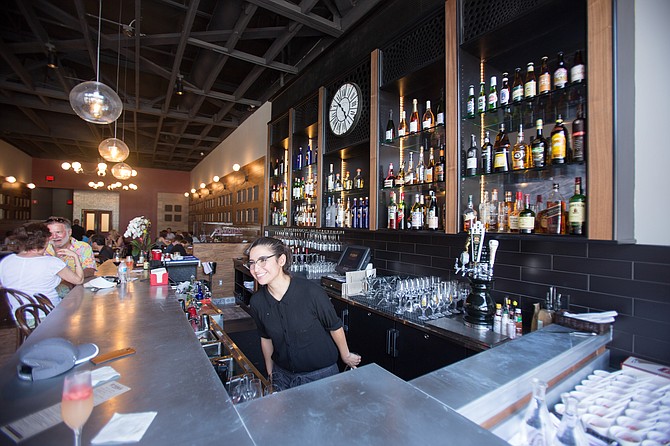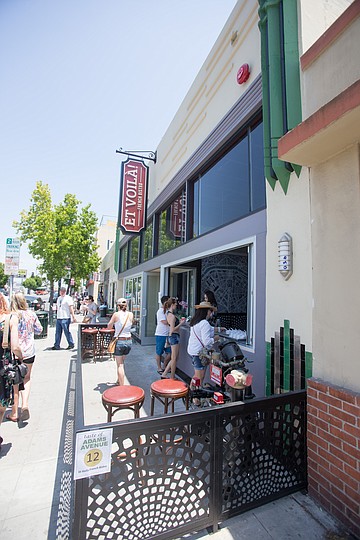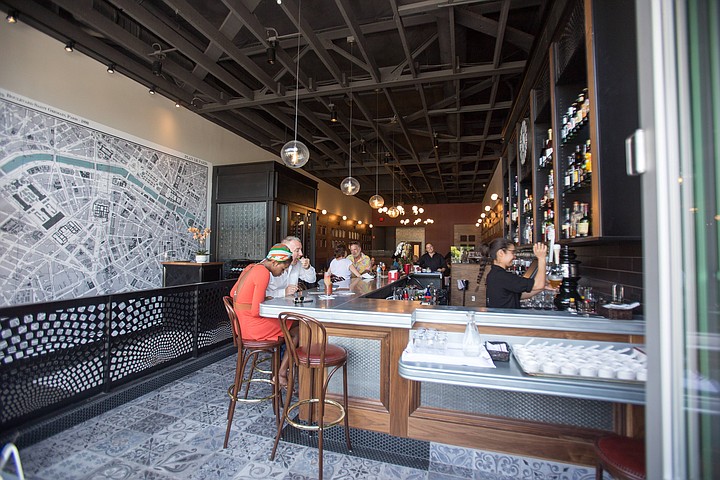 Facebook
Facebook
 X
X
 Instagram
Instagram
 TikTok
TikTok
 Youtube
Youtube

For those who didn’t catch Barbarella’s take on Et Voilà in June, here’s the TL;DR version: she found the restaurant charming, (i.e. “a ‘nice’ establishment, yet you don’t feel out of place if you happen to be wearing a sweatshirt rather than a jacket”), a bit hit-or-miss on the food (though good enough that she would return), and it included a server with a vague grasp of French pronunciation.

Most of that holds. Et Voilà’s kitchen relies on bistro standards (steak frites, mussels and fries, duck confit, onion soup, escargot, coq au vin, et. al.), but some of the dishes seem to have a bit of an identity crisis. The duck confit (plenty crispy now) has overarching tones of barbecue sauce, and there’s a crab cake sitting underneath the salmon. With Sazeracs and the “Louisiane” on the cocktail menu, it’s almost like there’s a New Orleans Creole effect somewhere in the making, but not quite.

Don’t get me wrong, I dig Southern-comfort food, but these probably accidental effects aren’t working out. The lack of identity does a disservice to Et Voilà. The long and short of it is that Parc Bistro, recently opened in Bankers Hill, is better worked out, largely because it doesn’t get lost in its own menu.
The more interesting story lives in the trappings. There are no reclaimed wood tables in Et Voilà, and all the chairs match. The food does not rest atop whimsical non-plates, and nobody pours water into or out of Mason jars. Neither puns nor deliberate vagueness (such as listing a side dish as simply “starch”) obscure the menu’s mostly straightforward rundown of bistro fare, and only one item (the too-herby “homemade” gazpacho) purposefully reminds diners that it was in fact made at the restaurant.
In short, Et Voilà’s sense of style bespeaks almost nothing that we’ve come to expect from the countless hipster taverns opening hot on each other’s heels this past decade. I, for one, am sick of cookie-cutter public houses touting tarted-up bar food as the next big thing.
Et Voilà doesn’t have that vibe. Instead, Catalan-pressed cement tiles (unquestionably the most attractive floor covering in the history of ever) and Art Nouveau scalloping lend an early-20th-Century vibe to the floors and wainscotting. Dark-wood paneling and austere ironwork fixtures might have been lifted from someone’s composite vision of pre-war French cinema. Much like the aforementioned Parc Bistro, there is nothing ironic, cheeky, or edgy at Et Voilà.
The aesthetic of popular restaurants is in flux, which is what fashion tends to do, after all. Et Voilà’s look is no accident.


For those who didn’t catch Barbarella’s take on Et Voilà in June, here’s the TL;DR version: she found the restaurant charming, (i.e. “a ‘nice’ establishment, yet you don’t feel out of place if you happen to be wearing a sweatshirt rather than a jacket”), a bit hit-or-miss on the food (though good enough that she would return), and it included a server with a vague grasp of French pronunciation.

Most of that holds. Et Voilà’s kitchen relies on bistro standards (steak frites, mussels and fries, duck confit, onion soup, escargot, coq au vin, et. al.), but some of the dishes seem to have a bit of an identity crisis. The duck confit (plenty crispy now) has overarching tones of barbecue sauce, and there’s a crab cake sitting underneath the salmon. With Sazeracs and the “Louisiane” on the cocktail menu, it’s almost like there’s a New Orleans Creole effect somewhere in the making, but not quite.

Don’t get me wrong, I dig Southern-comfort food, but these probably accidental effects aren’t working out. The lack of identity does a disservice to Et Voilà. The long and short of it is that Parc Bistro, recently opened in Bankers Hill, is better worked out, largely because it doesn’t get lost in its own menu.
The more interesting story lives in the trappings. There are no reclaimed wood tables in Et Voilà, and all the chairs match. The food does not rest atop whimsical non-plates, and nobody pours water into or out of Mason jars. Neither puns nor deliberate vagueness (such as listing a side dish as simply “starch”) obscure the menu’s mostly straightforward rundown of bistro fare, and only one item (the too-herby “homemade” gazpacho) purposefully reminds diners that it was in fact made at the restaurant.
In short, Et Voilà’s sense of style bespeaks almost nothing that we’ve come to expect from the countless hipster taverns opening hot on each other’s heels this past decade. I, for one, am sick of cookie-cutter public houses touting tarted-up bar food as the next big thing.
Et Voilà doesn’t have that vibe. Instead, Catalan-pressed cement tiles (unquestionably the most attractive floor covering in the history of ever) and Art Nouveau scalloping lend an early-20th-Century vibe to the floors and wainscotting. Dark-wood paneling and austere ironwork fixtures might have been lifted from someone’s composite vision of pre-war French cinema. Much like the aforementioned Parc Bistro, there is nothing ironic, cheeky, or edgy at Et Voilà.
The aesthetic of popular restaurants is in flux, which is what fashion tends to do, after all. Et Voilà’s look is no accident.
Comments